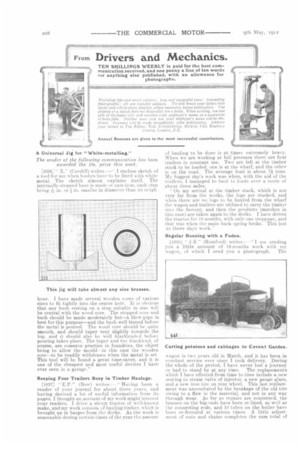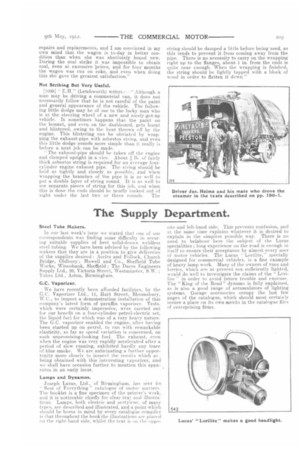TEN SHILLINGS WEEKLY is paid for the best coinforAmmimige munication
Page 22

Page 23

If you've noticed an error in this article please click here to report it so we can fix it.
received, and one penny a line of ten words A tor anything else published, with an allowance for .7 r photographs.
A Universal Jig for "White-metalling."
The sender of the following communication has been awarded the 10s. prize this week.
(1036] " X," (Cardiff) writes;—" I enclose sketch of a tool for use when bushes have to be lined with white metal, The sketch almost explains itself. The internally-stepped base is made ot east-iron, each step being A in. or in. smaller in diameter than its neigh hour. I have made several wooden cores of various sizes to fit tightly into the centre hole. It is obvious that any bush resting on a step suitable in size will be central with the wood core. The stepped core and bush should be made moderately hot—a blow-pipe is best for this purpose—and the bush well tinned before the metal is poured. The wood core should be quite smooth, and should taper very slightly towards the top, and it should also be well blackleaded before pouring takes place. The taper and the blacklead. of course, are common practice in foundries, the object being to allow the mould—in this case the wooden core—to be readily withdrawn when the metal is set This tool will be found a great time-saver, and it is one of the cheapest and most useful devices I have ever seen in a garage."
Keeping Four Trailers Busy in Timber Haulage.
[1037] " E.P." (Bow) writes :—" Having been a reader of your journal for about. three years, and having derived a. lot of useful information from its pages, I thought an account of my work might. interest your readers. I drive a steam tractor of well-known make, and my work consiste of hauling timber, which is brought up in barges from the docks. As the work is seasonable during certain times of the year the amount ofhauling to be done is at times extremely heavy. When we are working at. full pressure there, are four trailers in constant use. Two are left at the timber stack to be loaded, one is at the wharf, and the other is on the road. The average load is about 7 tons. My biggest. day's work was when, with the aid of the trailers, I managed to haul 14 loads over a route of about three miles.
" On my arrival at the timber slack, which is not very far from the works, the logs are stacked, and when there are no logs to be hauled from the wharf the wagon and trailer are utilized to carry the timber into the factory, and then the products (matches in this case) are taken again to the docks. I have driven the tractor for 15 months, with only one stoppage, and that was when the main back spring broke. This lost its three days work."
Regular Running with a Foden.
[1038] J.S." (Romford) writes -" I am sending you a little account of 12-months work with my wagon, of which I send you a photograph. The
wagon is two years old in March, and it has been in constant service ever since I took delivery. During the whole of the period, I have never lost a journey or had to stand by at any time. The replacements which I have effected from time to time include a new seating to steam valve of injector, a new gauge glass, and a new iron tire on rear wheel. This last replacement was necessitated by the breakage of the old tire owing to a flaw in the material, and not in any way through wear. As far as repairs are concerned. the brasses on the big-ends have been re-lined, as well as the connecting rods, and 10 tubes on the boiler have been re-ferruled at various times. A little adjustment of nuts and chains completes the sum total of
repairs and replacements, and I am convinced in my own mind that the wagon is to-day in better condition than when she was absolutely brand new, During the coal strike it was impossible to obtain opal, even at excessive 'prices, and for four months the wagon was run on coke, and even when doing this she gave the greatest satisfaction."
Not Striking But Very Useful.
[1039j " E.H." (Letchworth) writes Although a man may be driving a commercial van, it does not necessarily follow that he is not careful of the paint and general appearance of the vehicle. The following little dodge may be of use to the lucky man who is at the steering wheel of a new and nicely-got-up vehicle. It sometimes happens that the paint on the bonnet, and even on the dashboard, gets burnt and blistered, owing to the heat thrown off by the engine. This blistering can be obviated by wrapping the exhaust-pipe with asbestos string, and even this little dodge sounds more simple than it really is before a neat job can be made.
" The exhaust-pipe should be taken off the engine and clamped upright in a. vice. About lb. of fairly thick asbestos string is required for an average fourcylinder engine exhaust pipe. The string should be held as tightly and closely as possible, and when wrapping the branches of the pipe it is as well to put a double layer of string round. It is as well to use separate pieces of string for this job, and when this is done the ends should be neatly tucked out of sight under the last two or three rounds. The string should be damped a little before being used, as this tends to prevent it from coming away from the pipe. There is no necessity to carry on the wrapping right up to the flanges, about 1 in. from the ends is quite near enough. When the wrapping is finished, the string should be lightly tapped with a block of wood in order to flatten it down."
























